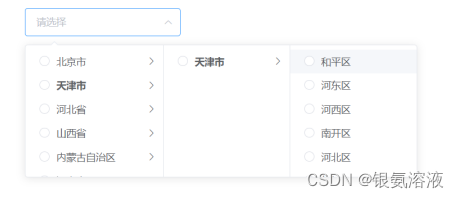java省市区树状实现(递归)
发布时间:2024年01月10日
想必看到这篇博客的朋友已经对我接下来要进行描述的知识有了一定的了解,那废话不多说,我们就具体来讲讲如何实现省市区的联查。
最终实现效果:

我的项目是Springboot+mybatis-plus,所以请先导入相关依赖哦~
以下是数据库中字段及解释:

接下来,我们需要导入以下依赖:
<dependency>
<groupId>cglib</groupId>
<artifactId>cglib</artifactId>
<version>3.3.0</version>
</dependency>然后是实体类:
@Data
@Builder(toBuilder = true)
@NoArgsConstructor
@AllArgsConstructor
public class City implements Serializable {
private long id;
private java.sql.Timestamp createTime;
private java.sql.Timestamp updateTime;
private String name;//省或市或区对应的名字
private String code;//省或市或区对应的编码
private long level;//省或市或区对应的层级,省对应1,市对应2,区对应3
private Integer parentId;//父id
private String acronym;
private long sort;
@TableField(exist = false)
private List<City> children;//非数据库中字段
}除了最后一个children字段为非数据库字段外,其它均为数据库中字段。
由于我是用代码生成器生成的dao和service的接口和实现,所以这里就不做过多展示了,然后我们进入到controller层:
public R<List<City>> listRegion() {
// 获取数据库中的所有数据
List<City> list=cityMapper.selectList(null).stream().map(city-> CglibUtil.copy(city, City.class)).collect(Collectors.toList());
// 根据数据库中的level字段,获取所有level为1的数据并做成一个集合,即获取所有父节点(省)
List<City> pro=list.stream().filter(civ -> civ.getLevel() == 1).collect(Collectors.toList());
// 根据获取的省的id获取对应省下面的市,然后做成集合
pro.forEach(oneProvince->{
List<City> city=list.stream().filter(c->c.getParentId()==oneProvince.getId()).collect(Collectors.toList());
// 根据当前市的id获取相应市下面的区的数据,然后通过collect(Collectors.toList()包装成集合
city.forEach(oneCity->{
List<City> town=list.stream().filter(c-> c.getParentId() == oneCity.getId()).collect(Collectors.toList());
oneCity.setChildren(town);
});
oneProvince.setChildren(city);
});
return R.Success(pro);
}代码中均做有注释,如若仍存在疑问的请留言~
?
文章来源:https://blog.csdn.net/qq_71416673/article/details/135425904
本文来自互联网用户投稿,该文观点仅代表作者本人,不代表本站立场。本站仅提供信息存储空间服务,不拥有所有权,不承担相关法律责任。 如若内容造成侵权/违法违规/事实不符,请联系我的编程经验分享网邮箱:chenni525@qq.com进行投诉反馈,一经查实,立即删除!
本文来自互联网用户投稿,该文观点仅代表作者本人,不代表本站立场。本站仅提供信息存储空间服务,不拥有所有权,不承担相关法律责任。 如若内容造成侵权/违法违规/事实不符,请联系我的编程经验分享网邮箱:chenni525@qq.com进行投诉反馈,一经查实,立即删除!
最新文章
- Python教程
- 深入理解 MySQL 中的 HAVING 关键字和聚合函数
- Qt之QChar编码(1)
- MyBatis入门基础篇
- 用Python脚本实现FFmpeg批量转换
- 浅研究下 DHCP 和 chrony
- 代码随想录算法训练营第二十六天 | 回溯算法part3
- AcWing P89:a^b(快速幂)
- 野火stm32指南针入门篇作业1
- springboot整合mongodb批量修改和添加索引
- 制作 CentOS Stream9 的U盘系统启动盘
- 支持魔兽世界国际服买退?
- .什么是TypeScript接口
- 鸿蒙开发已解决-彻底解决ModuleNotFoundError: No module named ‘exceptions‘
- 第二百七十九回